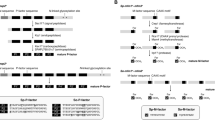Summary
A Saccharomyces cerevisiae a strain carrying the secretory mutation sec1, sec7 or sec18 showed no sexual agglutination ability when treated with α pheromone at the restrictive temperature 36° C, although the a agglutination substance had accumulated in the cytoplasm. These cells became sexually agglutinable, with a concomitant decrease in the agglutination substance in the cytoplasm, when the temperature was shifted from 36° C down to the permissive temperature 24° C after the addition of, cycloheximide. The a agglutination substance was barely detectable in sec53 cells (a) treated with α pheromone at 36° C, indicating that the active a agglutination substance was formed after the export of its precursor into the endoplasmic reticulum. These results indicate that the a agglutination substance is exported through the yeast secretory pathway and that α pheromone acts at the level of synthesis of the precursor molecule of the substance. An α strain carrying sec1, sec7 or sec18 behaved just like an a strain carrying the sec gene in the induction of agglutination ability by the opposite mating type sex pheromone.
Similar content being viewed by others
References
Doi S, Yoshimura M (1978) Temperature-dependent conversion of sexual agglutinability in Saccharomyces cerevisea. Mol Gen Genet 162:251–257
Ferro-Novick S, Novick P, Field C, Schekman R (1984) Yeast secretory mutants that block the formation of active cell surface enzymes. J Cell Biol 98:35–43
Hagiya M, Yoshida K, Yanagishima N (1977) The release of sex-specific substances responsible for sexual agglutination from haploid cells of Saccharomyces cerevisiae. Exp Cell Res 104:263–272
Novick P, Schekman R (1979) Secretion and cell-surface growth are blocked in a temperature-sensitive mutant of Saccharomyces cerevisiae Proc Natl Acad Sci USA 76:1858–1862
Novick P, Field C, Schekman R (1980) Identification of 23 complementation groups required for post-translational events in the yeast Saccharomyces cerevisiae Cell 21:205–215
Scheckman R (1983) The secretory pathway in yeast. In: Hunt T, Prentis S, Tooze J (eds) DNA makes RNA makes protein. Elsevier Biochemical Press New York, pp 278–284
Schekman R, Novick P (1982) The secretory process and yeast cell surface assembly. In: Strathern JN, Jones EW, Broach JR (eds) Te molecular biology of the yeast Saccharomyces. Metabolism and gene expression. Cold Spring Harbor Laboratory, Cold Spring Harbor, NY, pp 361–398
Shimoda C, Yanagishima N (1975) Mating reaction of Saccharomyces cerevisiae. VIII. Mating-type-specific substance responsible for sexual cell agglutination. Antonie van Leeuwenhoek 41:521–532
Somogyi M (1952) Notes on sugar determination. J Biol Chem 195:19–23
Tohoyama H, Yanagishima N (1981) Changes in sexual agglutination ability during the formation of vegetative cells from spores in Saccharomyces cerevisiae. Mol Gen Genet 183:205–208
Tohoyama H Yanagishima N (1982) Control of the production of the sexual agglutination substance by the mating type locus in Saccharomyces cerevisiae: Simultaneous expression of specific genes for a and α agglutination substances in matα2 mutant cells. Mol Gen Genet 186:322–327
Tohoyama H, Hagiya M, Yoshida K, Yanagishima N (1979) Regulation of the production of the agglutination substances responsible for sexual agglutination in Saccharomyces cerevisiae: Changes associated with, conjugation and temperature shift. Mol Gen Genet 174:269–280
Yamaguchi M, Yoshida K, Yanagishima N (1982) Isolation and partial characterization of cytoplasmic α agglutination substance in the yeast Saccharomyces cerevisiae. FEBS Lett 139:125–129
Yamaguchi M, Yoshida K, Yanagishima N (1985) Isolation, and biochemical and biological characterization of an a-mating-type-specific glycoprotein responsible for sexual agglutination from the cytoplasm of a cells, in the yeast Saccharomyces cerevisiae. Arch Microbiol 140:113–119
Yanagishima N (1984) Mating systems and sexual interactions in yeast. In: Linskens HF, Heslop-Harrison J (eds) Cellular interactions Encycl Plant Physiol NS17, Springer-Verlag, Berlin Heidelberg New York Tokyo, pp 402–423
Yanagishima N, Yoshida K, Hamada K, Hagiya M, Kawanabe Y, Sakurai A, Tamura S (1976) Regulation of sexual agglutinability in Saccharomyces cerevisiae of a and α types by sex-specific factors produced by their respective opposite mating types. Plant Cell Physiol 17:439–450
Yoshida K, Hagiya M, Yanagishima N (1976) Isolation and purification of the sexual agglutination substance of mating type a cells in Saccharomyces cerevisiae. Biochem Biophys Res Commun 71:1085–1094
Yoshida K, Yanagishima N (1978) Intra- and intergeneric mating behaviour of ascosporogenous yeast. I. Quantitative analysis of sexual agglutination. Plant Cell Physiol 19:1519–1533
Author information
Authors and Affiliations
Additional information
Communicated by C.P. Hollenberg
Rights and permissions
About this article
Cite this article
Tohoyama, H., Yanagishima, N. The sexual agglutination substance is secreted through the yeast secretory pathway in Saccharomyces cerevisiae . Molec Gen Genet 201, 446–449 (1985). https://doi.org/10.1007/BF00331337
Received:
Issue Date:
DOI: https://doi.org/10.1007/BF00331337




